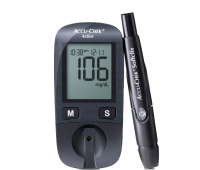User Manuals
Screen Messages
Accu-chek Active Meter Error Codes



The Accu-Chek Active blood glucose meter packs many powerful features into a smaller size. No coding reduces handling steps, see test result averages up to 90 days, get alerts if your test strips are expired or if you’ve underdosed, re-dose within 10 seconds, set pre-and post-meal reminders to test, and more.
Product Manualsaccurate:
easy:
safe:
clever:
Remark:
Previous Accu-Chek Active meter generations will be upgraded to no coding via black activation chip . Know more>>
1The Accu-Chek Active bGM system meets the DIN EN ISO 15197:2013 requirements (data on file, 2014).
Accu-Chek Active meter (Model GB)
See type plate on the back of the meter
Determination of glucose in fresh capillary blood by reflectance photometry.
Blood glucose values can be tested in whole blood or plasma.
The meter displays blood glucose values corresponding to those in plasma.
10-600 mg/dL
1-2 μl
Test strip in the meter: approx. 5 seconds
Test strip outside the meter: approx. 08 seconds
1 battery (type CR2032)
approx. 1000 tests or approx. 1 year
after 30 or 90 seconds depending on operating status
500 test results with time and date, as well as 7, 14, 30 and 90 days averages
During testing: +8 to +42°C
During storage without battery: -25 to +70°C
During storage with battery: -20 to +50°C
During testing: up to 85% relative humidity
During testing: up to 93% relative humidity
Sea level to 4000 m
97.8 x 46.8 x 19.1 mm
Without battery: approx. 46 g
With battery: approx. 50 g
96-segment liquid crystal display (LCD)
USB (Micro B)
III
The Accu-Chek Active meter meets the electromagnetic immunity requirements and the electromagnetic emissions requirements as per EN 61326-2-6 and EN ISO 15197 Annex A.
The chosen basis for electrostatic discharge immunity testing was basic standard IEC 61000-4-2.
Calibration and traceability: The performance data for the Accu-Chek Active bGM system was calibrated using venous blood containing various glucose concentrations. Reference values are obtained using the hexokinase method, which is calibrated using the ID-GCMS method.
The Accu-Chek Active bGM system meets the DIN EN ISO 15197:2013 requirements (data on file, 2014).
Testing your blood glucose is an essential part of managing diabetes. The Accu-Chek Active blood glucose meter can help to make it convenient by giving you fast, hassle-free, and accurate results in 4 simple steps.